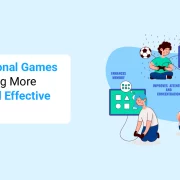Both immersive learning and experiential learning play a significant role in modern education and training. While they may appear similar, their methods, approaches, and applications differ greatly. Understanding these differences can help educators, trainers, and organizations choose the right learning strategy.
Unlock the nuances of immersive vs. experiential learning with Hurix Digital. Dive into our comprehensive insights to enhance your educational strategies. Contact us now to know more!

What is Immersive Learning?
Immersive learning integrates technology-driven methods to create interactive and engaging experiences for learners. It focuses on full engagement through Virtual Reality (VR), Augmented Reality (AR), and interactive simulations.
Key Characteristics of Immersive Learning
- Uses technology like VR, AR, and 3D simulations to create lifelike scenarios.
- Encourages full cognitive engagement requiring learners to interact actively.
- Gamification elements such as points, rewards, and interactive storytelling enhance motivation.
- Enables learners to repeat simulations for deeper understanding.
- Ideal for high-risk training, such as medical procedures or flight simulations.
Benefits of Immersive Learning
- Provides real-world scenarios for hands-on learning.
- Reduces learning risks by allowing practice in safe virtual environments.
- Improves knowledge retention through interactive participation.
- Helps learners develop critical thinking and problem-solving skills.
What is Experiential Learning?
Experiential learning, on the other hand, focuses on hands-on experiences without necessarily integrating technology. It follows the “learning by doing” approach, where learners engage in real-world activities to acquire skills.
Key Characteristics of Experiential Learning
- Encourages learners to apply knowledge in practical scenarios.
- Less reliant on technology; can be done through real-world projects or group activities.
- Uses reflection-based learning, where students analyze their actions.
- Encourages collaboration and teamwork through hands-on projects.
Benefits of Experiential Learning
- Fosters real-world problem-solving skills.
- Enhances teamwork and interpersonal communication.
- Builds adaptability by allowing learners to work through real-life challenges.
- Encourages self-motivation and independent thinking.
Choosing the Right Approach
Deciding between immersive learning vs experiential learning depends on the learning objectives.
- For highly interactive and technology-driven training, such as medical simulations or pilot training, immersive learning is beneficial.
- For skill-based, hands-on education, like business case studies or fieldwork, experiential learning is more effective.
Both approaches enhance learning, but blended strategies that combine both can offer the best results. Understanding their unique advantages allows organizations to create engaging, effective learning experiences suited to specific goals.



